I love all types of hot peppers and cook with them a lot. I have also become rather famous for my salsa, which only the brave seem willing to try. Because I use so many hot peppers so often in my cooking, I have found it much easier – and more cost-effective – to grow my own hot peppers. One of the most common hot peppers – and one of the easiest to grow – is the cayenne.
The cayenne pepper (Capsicum annuum) was probably grown for thousands of years in tropical and subtropical areas; however, it was never mentioned by Europeans until Peter Martyr d’Anghiera, an Italian-born historian, wrote about the cayenne pepper in 1493 after Christopher Columbus returned from one of his voyages with cayenne. Cayenne was considered to be a medicinal herb and used to treat such ailments as digestive problems, sinus infections, and even toothaches and joint pains. There is evidence that capsaicin, the active ingredient in hot peppers, does indeed aid in digestion by stimulating the production of saliva and gastric juices. The oil can also be placed on a cotton swab, which is then placed directly on an aching tooth to staunch the pain. Poultices made of cayenne peppers can stimulate the flow of blood around sore joints, thereby alleviating inflammation. In addition, cayenne peppers can help blood flow and improve circulation.
My daughter will attest to the fact that cayenne peppers, along with other types of hot peppers, can really help in the treatment of sinus infections. Her sinuses can give her quite a problem, which is when I usually get a phone call asking for some of my salsa. The capsaicin in the cayennes and other hot peppers does a fantastic job opening up the sinuses. She also, at one point, had a severe sinus infection, asthma, and pneumonia – all at the same time. She had been subscribed various drugs by the doctor, none of which were working. I got the phone call for salsa, with the added request to make it even hotter. She was better by the next day. In addition, I have had numerous friends who were absolutely amazed by how quickly and how well the hot peppers would open their sinuses and relieve the pressure. (The reaction is usually immediate.)
Cayenne peppers are also quite nutritious. For example, in 3.5 ounces of cayenne peppers, there are 369 milligrams of vitamin C and 21,600 I.U. of vitamin A. In addition, there are nice amounts of iron, potassium, and niacin.1 Finally, cayenne peppers are great for people concerned about their weight. Cayenne peppers are very low in calories, plus they help to speed up the metabolism and promote better digestion.
There are a couple of things that you should know about cooking with and eating cayenne peppers (or any hot peppers). If you do not wear gloves when preparing hot peppers – and who really remembers to do such a thing – you will probably notice at times that your fingers and hands feel like they are burning. The capsaicin works on the nerve endings, not the capillaries, which produces this burning sensation. A simple solution that will stop the burn is to squeeze lemon juice on your fingers and hands. (I keep a bottle on the counter next to me when I am cooking with hot peppers.) The acid in the lemon juice will douse the fire. Also, people tend to grab a glass of water or soda after taking too-hot of a bite of the hot peppers. The capsaicin, once again, is causing the heat; and capsaicin is an oil. All you need to remember is that “oil and water do not mix.” You should grab a glass of milk instead. The lactose in the milk will counteract the heat.
As I mentioned before, cayenne peppers are quite easy to grow. In tropical areas, they can be grown as perennials; however, most of us in the United States grow them as annuals. Cayenne peppers like heat, so plant them in full sun. I find it easier to plant seedlings rather than starting my cayenne peppers from seed. Also, it takes about 70 days for cayenne peppers to begin to mature. Since they cannot be planted until after the last frost, which can be in May in my Zone 6 area of Tennessee, seedlings give me an earlier harvest. Cayenne peppers also have a long growing period – about 14-18 weeks – and you can wind up with an abundance of peppers. Most people will dry the cayennes for use during the fall and winter months; however, I freeze all of my hot peppers. First, freezing is much easier. Second, the cayenne peppers and all of my other hot peppers taste just like fresh. I must warn you, though, that hot peppers that have been frozen can taste even hotter than those freshly picked from the bush.
You should also plant your cayenne peppers in fertile, organically-rich soil. (Do make sure that the soil is warm before planting. You can heat it up by covering it with black plastic before transplanting your cayenne peppers.) Keep your plants moist, especially during the initial stages following transplant. You will be well-advised to mulch them. If planting in the garden with other vegetables, keep your cayenne peppers at least three feet away from other plants, such as sweet bell peppers and carrots. (I planted some hot peppers near my radishes one year and had the hottest radishes in the area.) In fact, I would recommend giving your cayenne peppers their own little plot. You can also grow cayenne peppers in large containers on your deck.
If you have never tried growing your own cayenne peppers, this could be the year that you give them a try. You might find that the heat they produce is something that you can grow to love.
Kowalchik, Claire and Hylton, William H., eds. Rodale’s Illustrated Encyclopedia of Herbs. Emmaus, PA: Rodale Press, 1998, p. 76.
For more information on the medicinal uses of cayenne peppers, see: Healing Daily/Cayenne pepper for improved blood flow
Additional information can also be found at Dave’s Garden/Plant Files: Cayenne Pepper



